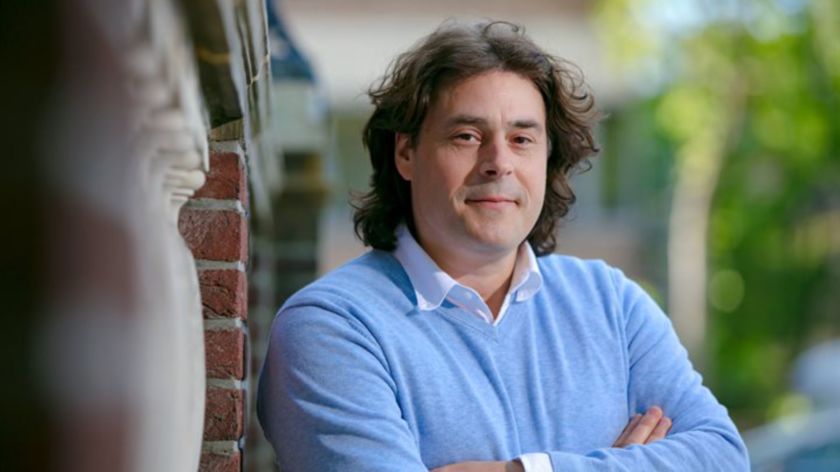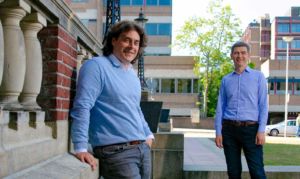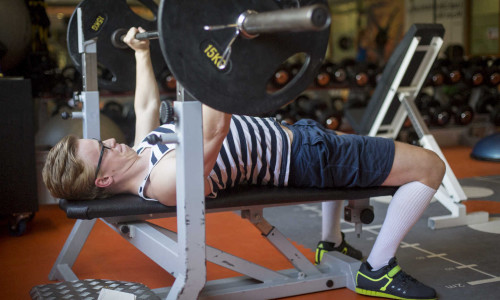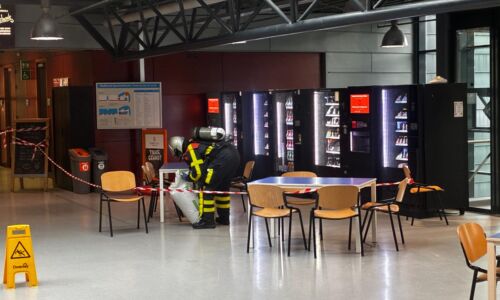Infectiologist Frank van de Veerdonk views every illness as a complex puzzle
-
 Frank van de Veerdonk. Photo: RU
Frank van de Veerdonk. Photo: RU
For almost two years, Frank van de Veerdonk from the Radboudumc has found himself in the eye of the corona-storm. During that period, the internist-infectiologist, who became a professor in November, discovered new ways in which corona grazes the immune system. However, he prefers to look into the future: ‘Hopefully one day, we will know exactly what every patient needs.‘
His professorship had already been in the works before corona, says immunologist Frank van de Veerdonk. ‘But the timing is rather good.’ Since the 1st of November, the Radboudumc internist holds the chair for Immunotherapy of Infectious Diseases – in the middle of a pandemic.
Van de Veerdonk’s research is primarily concerned with how infectious diseases can be fought with immunotherapy, a method in which the immune system receives a boost – more about that later. For the past two years, however, it was mainly corona that demanded his attention. Starting in spring 2020, during the first lockdown, with his discovery on why some corona patients’ lungs were filled with moisture. A dangerous situation, explains the professor. ‘Moisture does not only lead to respiratory problems, but it can also potentially cause dangerous inflammatory reactions and lead to other complications.’
The symptoms reminded Van de Veerdonk of patients with the rare condition hereditary angioedema (HAE) that show similar symptoms.
Passing in between
To understand how this works precisely, we have to take a look into the inner workings of our bodies. With HAE, for starters, patients’ blood vessels leak fluid because the vessels’ walls become porous as they stretch. The cells that form the outside of the blood vessel are then no longer lying tightly against each other, causing water molecules to pass in between. This leaks into the lungs and the patient has trouble breathing.
The cause of this vasodilation is an excess of bradykinin, a specific signal substance in the blood. When this bradykinin attaches onto a specific substance on the outside of the blood vessel cells – the so-called bradykinin receptor – the blood vessel is told: I have to widen.
Everyone has bradykinin. In a regular situation, it is kept in check by another substance. But let’s assume that this substance – the so-called ACE2 receptor – would be the first victim of the coronavirus as soon as it enters the lungs. Then bradykinin, Van de Veerdonk suspected, could act uncontrollably, with all the moisture issues that entails.
Holy grail
During his own research, that particular idea was confirmed when corona patients recovered after receiving incatibant, a medication that blocks the action of the bradykinin receptor. But don’t be mistaken, warns the internist, the holy grail of corona treatment hasn’t been found in incatibant. ‘Incatibant only works in the short term and therefore isn’t optimal. You have to inject it three times a day. And the timing is important: if the inflammatory response has already started, you’re too late.’
Because of that, the professor focussed on a drug with a long-term effect: lanadelumab. This drug is supposed to inhibit the production of bradykinin, but a first study – financed by ZonMW – didn’t show the hoped-for effect. ‘It has no effect on the concentration of bradykinin in the blood. We had to go back to the drawing board.’
‘COVID opens up a whole new field’
That isn’t bad, says Van de Veerdonk. In fact, he is fond of those kinds of complex puzzles. It makes him wonder whether the whole mechanism of blood vessel dilation might just work a little differently than expected. That is precisely why he followed up his choice for internal medicine with immunology, and finally opted for the opportunity of a professorship. ‘I’m an immensely curious person and always wanted to know how things work.’ Immunology, with all its complexity, provides more than enough room for this. ‘COVID opens up a whole new field.’
Ventilation
The nice thing about immunology is, he explains further, that colleagues sometimes ask for a second opinion on admitted patients that show symptoms that they don’t understand. A bit like the eponymous dr. House from the early-2000s television show. ‘It regularly turns out that something is wrong with their immune system.’ Like in the case of the two young brothers, not even 35, that had to be put on a ventilator because of corona last year. It turned out that they had a genetic abnormality that disrupted their immune system. Those insights resulted in publications in, among others, the leading medical journal JAMA.
At the end of the day, however, Van de Veerdonk is working primarily for his patients. Working exclusively on fundamental research questions without a clear link to clinical practice wouldn’t make him happy. ‘I’m a different type, really. For me, a research question starts with the patient, and answering it comes right back to the patient as well – in the most optimal case, in the form of treatment.’
CV
Frank van de Veerdonk (1975) studied medicine at the Vrije Universiteit Amsterdam. After that, he worked at the Jeroen Bosch Hospital in Den Bosch. Since 2005, he has been working for the Radboudumc. Here, he specialized in internal medicine and completed his doctorate in 2011. Since then, he is an internist-infectiologist and works as a researcher and a clinical practitioner. On the 1st of November 2021, he became the professor for Immunotherapy for Infectious Diseases. In 2020, Van de Veerdonk received the Hermesdorfprijs from Radboud University, together with a team of other COVID-researchers from the Radboudumc, including Mihai Netea, Roger Brüggemann, Leo Joosten and Alexander Hoischen.
His commitment to clinical applications of medical research is shared with his regular colleagues such as, among others, Mihai Netea and Jos van der Meer. The latter of whom, professor emeritus for infectiology, brought him to Nijmegen in 2005.
Lead globally
One of his goals as a professor is to further advance this application-oriented approach to research. ‘I think that this approach is one of our strong points here in Nijmegen. We want to understand mechanisms of illnesses and apply those insights to clinical practice.’
One of his hopes is, for example, that in five years’ time, the Radboudumc will be able to conduct clinical trials of immunotherapy for infectious diseases for so-called phase II research. That is the stage of drug development during which substances are tested on a small group of people for the first time. Van de Veerdonk: ‘You can then do a sort of proof-of-concept study in order to see whether the medication works. This would put our hospital in a globally leading position, as we would then cover the entire range from the study in the lab to clinical trials.’
Exception
If a trial centrum like this had existed last year already, the test with icatibant for example would have been a bit easier to realize. Instead, Van de Veerdonk had to get special permission from the hospital to test the medication on a small number of patients, because of an absence of other treatment options at the time. ‘Without an own trial unit, you’ll lose time.’
This dream would also be a solution for the research branch most central to his own work: immunotherapy for infectious diseases. Compared to conventional drugs that directly attack a pathogen, immunotherapy gives a patient’s immune system a boost, a brake – or combines both. Hopefully, this will enable it to take care of bacteria, fungi or viruses itself.
In some cases of rheumatism or cancer, this form of treatment has increasingly been applied throughout the last few years. For infectious diseases, such as corona or influenza, this treatment is, however, still in the early stages. ‘This isn’t surprising’, states Van de Veerdonk. ‘Patients with rheumatism or cancer are ill for a long time. That gives you a lot of space to see how the immune system can be inhibited or enhanced in the best way.’
‘Immunotherapy could be a solution for some flu patients’
With a relatively short-term infection such as the flu, this is a lot more complicated. But immunotherapy could be a solution for some flu patients, explains the infectiologist. ‘Approximately one in five flu patients admitted to the intensive care unit also gets a nasty fungi infection in the lungs. Immunotherapy could possibly benefit them.’
A push in the right direction
Fungi are notoriously difficult to treat with medication. With a bit of luck, however, the immune system of the patient might be able to take care of it itself, if pushed in the right direction. There is still a long way to go towards this goal, says the professor, but it definitely is part of his vision of the future. ‘One day, I hope that we will know exactly what every individual patient needs, instead of treating everyone with the same approach.’
To be able to do so, it will be necessary to profile every single patient. Differently put: typifying according to individual characteristics such as DNA and biomarkers (indicators such as a certain molecule or blood value that can be related to a disease). Following that, you would be able to give personalized treatments. Profiling can also help to understand why some get an infection and others remain uninfected. No matter if you are dealing with a fungus or corona.




